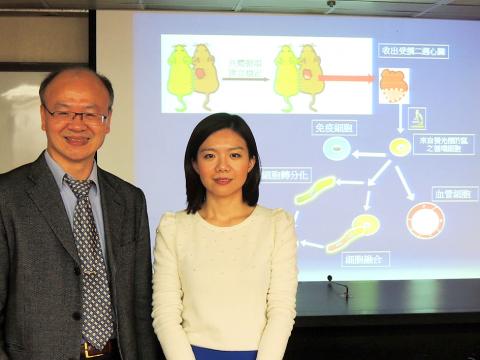Scientists from the Academia Sinica yesterday unveiled research findings that offer new hope for tools to combat heart failure.
They said five years of research showed circulating blood cells contribute to heart cell regeneration after a heart attack by fusing with heart cells (cardiomyocytes).
Team leader Patrick Hsieh (謝清河), an associate researcher at the Institute of Biomedical Science, said his team has discovered that heart inflammation triggered during the early stage of heart injury is essential for effective heart cell regeneration.

Photo: Tang Chia-ling, Taipei Times
However, their findings contradict those of a team led by former Stanford University researcher Bob Robbins — published in 2004 in the journal Nature — that said blood cells were unable to transform into heart cells, Hsieh said.
Robbins’ team used a parabiotic animal model — surgically joining two animals so that they share circulation, he said.
Hsieh said the difference in the two groups’ findings prompted him to experiment on the right timing to establish parabiotic circulation, so that early signals of inflammation in the heart can be promptly and effectively transmitted between test subjects.
By employing real-time molecular imaging in combination with Cre-Lox transgenic mice to pulse-trace blood stem cell genesis in the surgically conjoined animals, Hsieh’s team found that parabiosis between the rodents requires at least one week to become stabilized, he said.
Once that has been achieved, heart attacks can been induced in the recipient mice to achieve useful test results, Hsieh said.
The results showed that hematopoietic stem cells — the cells in charge of forming blood cells — of the label mouse begin to enter the recipient’s heart about one week after the recipient has had a heart attack, about which time the stem cells turn into heart cells by trans-differentiation and fusion with existing cells, Hsieh said.
He said the process, which also occurs in humans, begins at one week after a heart injury and is transient — something Robbins’ team failed to identify.
He said this team found two other flaws in the work by Robbins’ team — that from the beginning they used mice that had been given heart attacks, when parabiosis was still unstable, and then they waited up to a month before analyzing their results, which found that none of the label mice’s blood stem cells had circulated to the recipient’s heart.
Hsieh said his team’s discovery is significant because it successfully challenged the widely held view that no blood circulation cells can contribute to cardiomyocyte regeneration, as well as offering new prospects for preventing heart attacks.
Drugs developed based on his team’s discovery would significantly improve traditional therapies targeting heart failure, he said.
“Although we still have a long way to go, we hope to develop drugs to strengthen the process of hematopoietic stem cells entering the heart so that patients can benefit from natural, endogenous cardiomyocyte regeneration,” Hsieh said.

ANOTHER EMERGES: The CWA yesterday said this year’s fourth storm of the typhoon season had formed in the South China Sea, but was not expected to affect Taiwan Tropical Storm Gaemi has intensified slightly as it heads toward Taiwan, where it is expected to affect the country in the coming days, the Central Weather Administration (CWA) said yesterday. As of 8am yesterday, the 120km-radius storm was 800km southeast of Oluanpi (鵝鑾鼻), Taiwan’s southernmost tip, moving at 9kph northwest, the agency said. A sea warning for Gaemi could be issued tonight at the earliest, it said, adding that the storm is projected to be closest to Taiwan on Wednesday or Thursday. Gaemi’s potential effect on Taiwan remains unclear, as that would depend on its direction, radius and intensity, forecasters said. Former Weather Forecast

As COVID-19 cases in Japan have been increasing for 10 consecutive weeks, people should get vaccinated before visiting the nation, the Centers for Disease Control (CDC) said. The centers reported 773 hospitalizations and 124 deaths related to COVID-19 in Taiwan last week. CDC Epidemic Intelligence Center Director Guo Hung-wei (郭宏偉) on Tuesday said the number of weekly COVID-19 cases reported in Japan has been increasing since mid-May and surpassed 55,000 cases from July 8 to July 14. The average number of COVID-19 patients at Japan’s healthcare facilities that week was also 1.39 times that of the week before and KP.3 is the dominant

The Chinese Communist Party’s (CCP) working group for Taiwan-related policies is likely to be upgraded to a committee-level body, a report commissioned by the Mainland Affairs Council (MAC) said. As Chinese President Xi Jinping (習近平) is increasingly likely to upgrade the CCP’s Central Leading Group for Taiwan Affairs, Taiwanese authorities should prepare by researching Xi and the CCP, the report said. At the third plenary session of the 20th Central Committee of the CCP, which ended on Thursday last week, the party set a target of 2029 for the completion of some tasks, meaning that Xi is likely preparing to

US-CHINA TRADE DISPUTE: Despite Beijing’s offer of preferential treatment, the lure of China has dimmed as Taiwanese and international investors move out Japan and the US have become the favored destinations for Taiwanese graduates as China’s attraction has waned over the years, the Ministry of Labor said. According to the ministry’s latest income and employment advisory published this month, 3,215 Taiwanese university graduates from the class of 2020 went to Japan, surpassing for the first time the 2,881 graduates who went to China. A total of 2,300 graduates from the class of 2021 went to the US, compared with the 2,262 who went to China, the document showed. The trend continued for the class of 2023, of whom 1,460 went to Japan, 1,334 went to